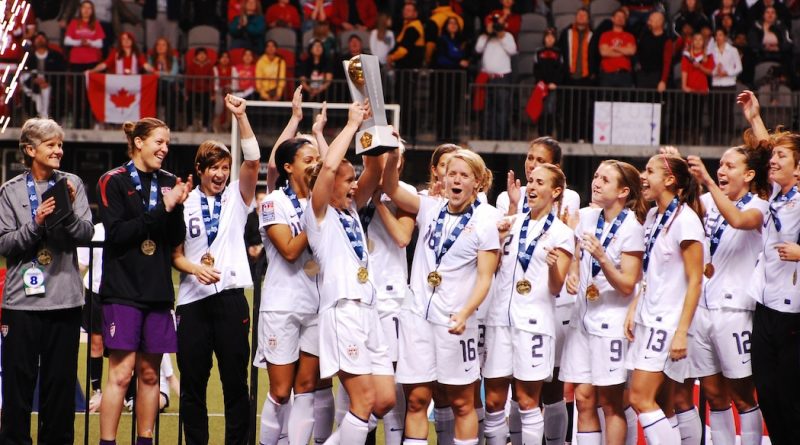The Real Tea On U.S. Women’s Soccer
Grant Little
Contributing Writer
“Mewis, Lavelle, Rose up the middle, looking, cutting, shooting, goal! Lavelle! Two nothing U.S.,” was the call by JP Dellacamera as the United States Women’s National Team (USWNT) claimed a lead that would prove insurmountable in the World Cup Final.
https://twitter.com/FOXSoccer/status/1146140792508960768?s=20
The USWNT had won its second consecutive World Cup and their fourth in total by beating the European Champions, the Netherlands, as nearly 16 million viewers tuned in to the U.S. television coverage.
After the confetti fell, the 23 U.S. champions headed back to the National Women’s Soccer League. There is cautious optimism that the 2019 FIFA Women’s World Cup will serve as a catalyst for the league to gain attraction in the eyes of the American public.
While World Cups have had a history of creating an initial spike in viewership and attendance, the league ultimately continued to struggle.
The Women’s United Soccer Association (WUSA) was the first women’s soccer league where all the athletes were paid professionals. It was founded in 2000 after the U.S. had hosted the Women’s World Cup, and Americans were captivated by the likes of Mia Hamm and Brandy Chastain’s iconic celebration as the USWNT won their second World Cup in front of 90,185 in a packed Rose Bowl.
The WUSA began its first season in April of 2001 with eight teams, but it did not last long. The league was ended on September 15, 2003 due to enormous financial losses.
After two failed attempts to relaunch the WUSA in 2004 and 2005, and the postponement of a relaunch in 2008, Women’s Professional Soccer (WPS) kicked off its inaugural season in 2009. The league was again losing money, and four teams were unable to meet the league’s payment deadline. This resulted in two of the four teams folding.
The success of the Women’s National Team in the 2011 World Cup provided another spike in attendance across the league. However, the league faced a slew of challenges and a lack of resources causing it to fold on May 18, 2012. The NWSL was started in 2013 and has since become the first U.S. women’s soccer league to survive three seasons.
Now that the successful 2019 Women’s World Cup has ended, the league has seen a spike in attendance like it had previously. The first fixtures after the World Cup broke attendance records all over the country. Chicago Red Stars had a sell out crowd of 17,388, Utah Royals had 15,931, Orlando Pride had 9,415 and Washington Spirit hosted a sellout of 5,500.
The World Cup has once again piqued interest in women’s soccer, but this time seems different. With big name sponsors like Budweiser investing in the league, and ESPN agreeing to air 11 games and the playoffs between ESPNEWS and ESPN2, we could finally see a women’s soccer league succeed in the U.S.
However, it has not all been positive for the NWSL. The league still does not have a TV partner for the 2020-2021 season and will only be streamed on Yahoo Sports.
If you were enamored by the USWNT during the World Cup, I urge you to watch the NWSL. It is a highly competitive, fast paced league. The entire women’s national team plays in the NWSL and many other World Cup stars, like Australia’s Sam Kerr, play in the league. There are still many other players who are talented who do not play for national teams.
The NWSL is comprised of nine teams: the Chicago Red Stars, Houston Dash, North Carolina Courage, Orlando Pride, Portland Thorns, Reign FC (Tacoma, Washington), Sky Blue FC (Piscataway Township, New Jersey) and the Washington Spirit. If you live by one of these teams, buy a ticket to a match and support your local team. If you do not have a local team, support the team of your favorite USWNT player.
Buy scarves, buy a jersey, buy tickets, watch games. You do not have to wait for the World Cup or the Olympics to support women’s soccer. We have a league in our own backyard and if we want the Women’s National Team to continue winning or achieve equal pay we must support the NWSL because we cannot afford for the league to collapse like it has in the past.
The more we support the league the better funded it will be and the more sponsors it will acquire, which will allow the league the chance to grow and prosper and even get a full season TV deal. The NWSL does not have the same opportunities and resources as MLS, and it needs our support. We must create a demand for the NWSL to create an equal playing field where the women’s league has the same exposure, opportunities and resources as the men’s league.
We should aim to be the fans lauded by Megan Rapinoe after the Ticker Tape victory parade, to be “more than a fan… more than someone who just supports sports…more than someone who just tunes in every four years…”
This Week’s Fixtures and Where to Watch:
July 27
Utah Royals vs. North Carolina Courage (ESPNEWS)
July 28
Reign FC vs. Chicago Red Stars (Yahoo Sports)
Houston Dash vs. Sky Blue FC (Yahoo Sports)

